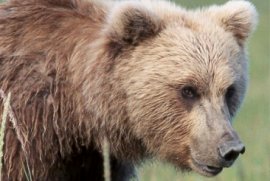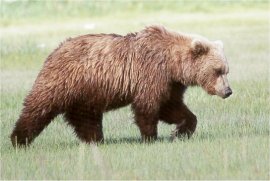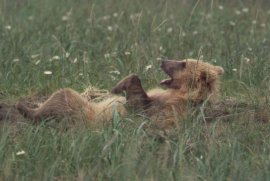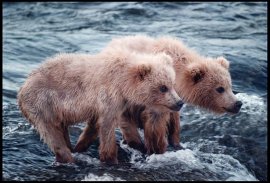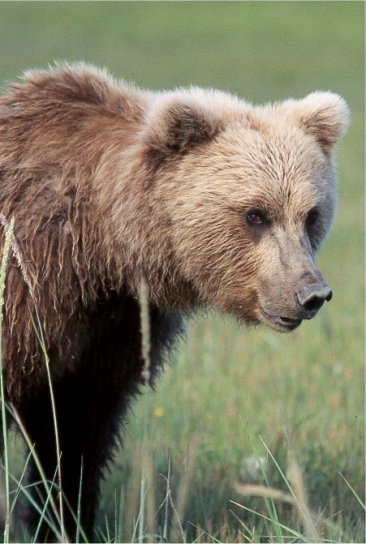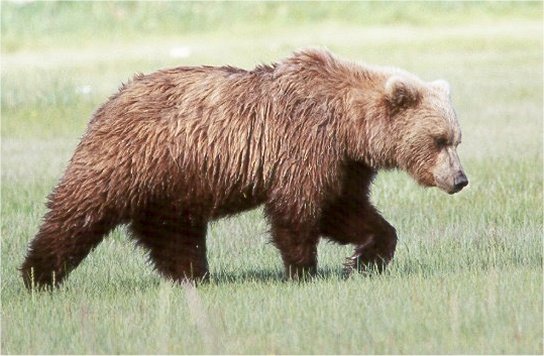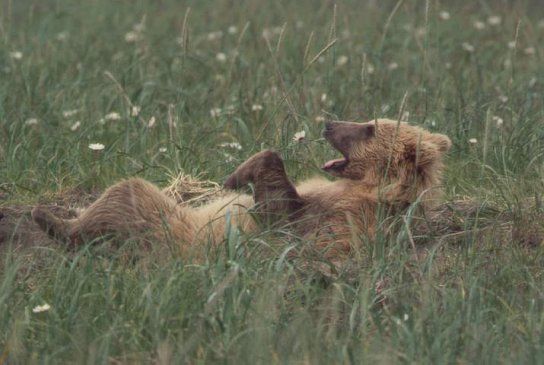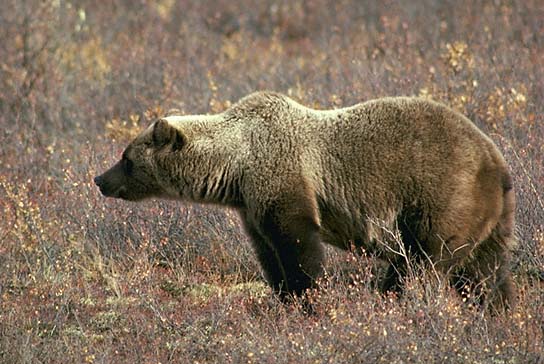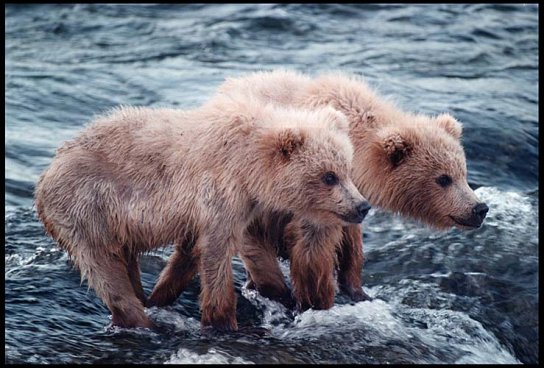Bears
Description
Yellowish brown to dark bown, often with white-tipped hairs, giving grizzled appearance. Hump above shoulders. Facial profile usually somewhat concave. Outer pair of incisors larger than inner 2. Claws of front feet nearly 4” (10 cm) long. Ht about 4’3” (130 cm); L 5’11”–7’ (180–213 cm); T 3” (7.6 cm); HF 10 1/4” (26 cm); Wt 324–1,499 lb (147–680 kg); some individuals to 1,700 lb (700 kg).
Habitat degradation, from recreational development, road building, and mineral and energy exploration, remains a threat today. Even the development of areas the Grizzlies don't live in, such as valley bottoms and riverbeds, can be destructive, because the bears use these as corridors to reach suitable feeding habitat. Some private landowners and companies have volunteered to protect these corridors on their land in order to protect the bears. Plans to reintroduce Grizzlies into suitable habitat have recently been nixed by the administration of George W. Bush.
Similar Species
Black Bear is smaller, lacks shoulder hump, and has straight or slightly convex facial profile; all 3 pairs of its upper incisors are equal in size.
Breeding
Mates late June–early July; litter of 1–4 young born January–March. Newborn weighs 1 lb (450 g).
Bed: Usually in thickets, oval depression about
1’ (300 mm) deep, 3’ (900 mm) wide, 4’ (1,200 mm) long, matted with
leaves, needles, or small boughs.
Scat: Usually cylindrical,
often more than 2” (50 mm) wide, possibly showing animal hair,
vegetation fibers, or husks. May be rounded, or massed in areas
where vegetation is the primary food.
Trails: Trampled in tall
grass and marked by deep depressions; may undulate.
Tracks:
Shaped and placed like those of Black Bear but larger, and with
long, relatively straight foreclaws farther ahead of toe pads;
hindclaws register only occasionally. Hindprint of large Grizzly may
be 10–12” (250–300 mm) long and 7–8” (175–200 mm) wide in front;
foreprint often as wide, about half as long. In soft mud, tracks may
be larger. Even on hard ground, Alaskan Brown Bears often leave
bigger prints, with hind tracks more than 16” (400 mm) long, 10 1/2”
(265 mm) wide, and sunk 2” (50 mm) deep. Stride averages 24” (600
mm); may be 8–9’ (2.4–2.75 m) during a bounding run.
Discussion
Primarily nocturnal, the great, shaggy Grizzly moves with a low, clumsy walk, swinging its head back and forth, but when necessary it can lope as fast as a horse. Grizzly cubs can climb, though not as nimbly as Black Bear cubs, but they lose their climbing ability during their first year. Omnivorous, the Grizzly Bear feeds on a wide variety of plant material, including roots, sprouts, leaves, berries, and fungi, as well as fish, insects, large and small mammals, and carrion. It is adept at catching fish with a swift snap of its huge jaws, and occasionally will pin a fish underwater with its forepaws, then thrust its head underwater to clasp the catch in its teeth. It digs insects from rotting logs and small mammals from their burrows, sometimes tearing up much ground in the process. It caches the remains of larger mammals, such as Elk, Moose, Mountain Goats, sheep, or livestock, returning to the cache until all meat is consumed. When salmon migrate upstream to spawn, these normally solitary bears congregate along rivers, and vicious fights may erupt among them. More often, they establish dominance through size and threats, spacing themselves out, with the largest, most aggressive individuals taking the choicest stations. In winter, Grizzlies put on a layer of fat, as much as 400 pounds (180 kg) worth, and become lethargic. They den up in a protected spot, such as a cave, crevice, dead tree, or a hollow dug out under a rock, and will return year after year to a good den. Not true hibernators, they can easily be awakened. A Grizzly in captivity has lived 47 years, but the life span in the wild is 15 to 34 years. Once regarded as a separate species, the Alaskan Brown Bear (U. a. middendorffi) is a very large subspecies of Grizzly, usually 800 to 1,200 pounds (360–545 kg) at eight or nine years of age, and eventually reaching 1,700 pounds (770 kg), making it the world’s largest terrestrial carnivore. This subspecies ranges over the coasts and islands of southern Alaska, including Kodiak Island, where it is known as the Kodiak Bear.

